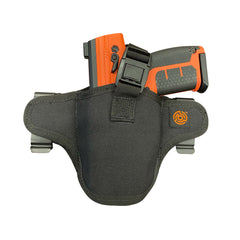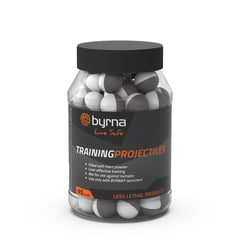
Dog walks can get tense when a quiet neighborhood suddenly fills with barking. These situations can seem pretty scary. More people are reporting unexpected run-ins while walking their dogs lately - my goal is to help you and your furry friend stay safe and show you what equipment works best for walks. Think of it as your friendly map to worry-free dog walking.
A poorly lit alley with just one streetlamp might hide dangers from unleashed dogs or unfamiliar people. I've learned this the hard way. I'll also talk about the common dangers, the gear you might need, and the helpful and legal considerations that can affect your options. When did you last even think about having a backup path ready? Just remember - this isn't meant to replace legal advice.
Let's get started looking at what types of problems you might run into during your walks.
Table of Contents
The Top Dog Walker Risks
Dog walking comes with more dangers than you might think. Professional dog walkers deal with real dangers when they're out with their furry charges. Accidents can still happen in seconds - a quick trip or sudden pull might leave you with an injury.
Falls cause most injuries for dog walkers. You can lose your balance when a dog lunges at another animal or pulls hard on the leash. Happens in a flash. These falls give you painful finger fractures and shoulder strains. In some cases, you might even suffer a traumatic brain injury. Always keep a firm grip on that leash and stay alert to your surroundings.
Recent studies show some pretty worrying patterns. Hospital records show that dog walking injuries have jumped dramatically over the last twenty years. That's also the case for those over 65; these falls tend to have serious results. The numbers make you think about taking some extra steps.

A client shared her frightening story with me just last month. "I was walking my retriever when a neighbor's unleashed dog charged at us from across the street," she told me. While she tried to control her panicking dog, she twisted her wrist. These stories happen more than most people know.
Weather plays a big part in these accidents, too. Winter walks become especially tough with icy sidewalks. Combine the slippery conditions with an excited dog pulling on the leash, and you have a perfect setup for injury. Experienced dog walkers stay away from some routes during bad weather days. You might want to follow familiar, well-maintained paths when the conditions aren't right.
Dogs aren't the only source of risk. Sometimes other people can present dangers while you're out walking. When you take your path through isolated areas or when you head out in the early morning darkness, it can make you feel vulnerable. Been there, felt that. That's why standard dog walkers carry some form of protection with them. Maybe try bringing along your phone and letting someone know your walking path. Using your phone while walking dramatically increases these dangers. When you look at your screen instead of what's around you, you'll miss important warning signs. You might not see an aggressive dog approaching until you don't have enough time to respond. Try to keep your phone in your pocket and stay aware of your surroundings.
Popular Protection Tools
You should just look for some defense gear that works from a distance when you're walking your dog. Ultrasonic devices can help - they make high-pitched sounds that dogs hear but most people can't. These sounds just startle approaching dogs without hurting them. You'll find that most of these devices come with wrist straps to make them accessible during your walks.
Dog spray deterrents give you some protection from as far as 12 feet away. When you have this extra space between you and a strange dog, it matters when things get tense. People who use these sprays have seen almost 70% fewer aggressive dog run-ins, according to recent studies. The products work based on solid science, too.
Different sprays work in different ways. Dogs hate the smell of citronella sprays. These won't harm them long-term. For more aggressive animals, pepper sprays with capsaicin are often helpful to stop them. No one wants that confrontation to happen. Make sure that you watch the direction of the wind when you use any spray. The last thing you want is to accidentally spray yourself or your own dog.
The telescope baton also gives you some extra reach without being too large. But they're not legal to carry everywhere. Local laws matter when you're picking out some defense tools. Some cities don't allow sprays, and others may need permits or flat-out ban some of these options. Check what's legal in your area before buying anything. It's much better to know this ahead of time than to fight a fine (or worse).

You need to practice with any defense tool to use it well when you need it. Get familiar with how it works before you have an emergency situation. Every second counts when an aggressive dog comes toward you. Most dog walkers eventually pick their favorite tools based on what'll work best for the problems in their neighborhood.
The personal protection market is now growing, which shows how people feel they need these products. Businesses expect we'll spend more than $2 billion on these items by 2025. As more people want these products, manufacturers are coming up with new options to meet the demand.
Local Self-Defense Laws
The laws about carrying self-defense tools actually change quite a bit from place to place when you're walking your dog. Dog walkers in Texas can legally carry some items that might get someone in California into trouble. Pet owners find this confusing when they're just trying to stay safe during their walks.
Chemical spray laws can vary depending on where you live. You could be allowed to carry some animal repellents in some places, while the human-targeted pepper spray remains banned. Animal sprays usually have lower concentrations of the active ingredients, and they're made to scare animals away without causing long-term damage.

Most cities just put strict limits on weapons like batons. Electronic tools like stun guns could be legal in one state and completely banned in another. You should take a few minutes to check your local laws - this small step can save you from problems down the road.
You'll find some gray areas in almost every city and state with these tools. We heard from a dog walker in Chicago who got a $50 fine even though she carried legal dog spray. So frustrating. When the police asked her, she couldn't show them that her spray was specifically made for use on animals.
Make sure that you get your information from official government websites or articles written by attorneys. The laws about self-defense tools are changing frequently. Something that was allowed last year might now need you to get a permit or take a training class.
Texas follows what they call "Stand Your Ground" laws, which means you don't have to try to run away if you're legally allowed to be somewhere - it's different from other states where you need to try to escape before any force. Remember that no matter where you are, the force you use should always match the level of threat you might have.
You help yourself if you need to explain your actions by keeping some records. You should hold onto receipts that show you bought legal versions of your deterrents. Why not also snap some pictures of the packaging that shows the product is meant for use against animals?
How to Carry Protection Gear (Safely)
Dog walkers buy pepper spray. But they just toss it in their pocket without thinking - this doesn't help you when you need protection.
You need to grab your safety tools much faster in urgent situations. When you attach it to a leash, you can clip it nearby so you don't have to dig through your pockets when the time matters.
The belt pouches work well for bigger items like stun guns. They hold everything protected while you walk or jog with your dog. Do you want another option to carry a few defense tools? Cross-body bags let you carry multiple items at once. Just make sure that you practice taking out your device until you can do it automatically.

Where you place your gear matters, too. If you're left-handed, you should arrange your defense tools to match how you naturally move. A right-handed setup might slow you down when every second counts during a tense situation.
Remember the evening walks when it's dark. The darkness changes the whole routine. You're on a narrow trail with a flashlight in one hand and your other hand near your spray - this ready position starts to feel very natural after you practice it a few times on your regular walks.
Don't leave your defense sprays in hot cars. The heat can damage what's inside or make the containers leak. Before you head out, always test that your safety caps work. A stuck safety mechanism gives you a false sense of security that might let you down when you need protection.
Just think about making your defense gear routine like putting on your seat belt - it's simply part of how you walk your dog responsibly. Practice grabbing your safety tools, and these habits will become second nature.
How to Teach Your Dog Emergency Skills
Your dog's behavior works way better than any safety tool when you're out walking. When you teach your dog to heel, they'll stay right next to you as strangers walk by - this helps to stop them from jumping toward anything scary on busy streets.
When you teach your dog to "leave it," it can keep you safe. Dogs find the strangest stuff. Say your dog finds a chicken bone someone dropped or spots an angry squirrel. When you say "leave it," they won't eat something that could hurt them or run after animals into the street.
Professional trainers recommend teaching the "behind me"command for city walks. When you see someone who looks sketchy or a dog without a leash, this command places you between your dog and the possible danger. You become a shield while you figure out what to do next.

You should focus some extra time on teaching your dog to come when called. If your dog returns to you, you can get them away from danger faster than any spray or device could. Try practicing this command in your yard every day before moving to more distracting places.
When you teach your dog to "settle," it helps them stay calm next to you when stuff gets stressful - it'll be helpful during emergencies when you need to manage things without your dog making it all more chaotic. Life gets noisy. Start practicing at home where there isn't much to distract them.
Most dog owners think that training classes are worth the money. City agility courses help dogs move around urban obstacles. Workshops for reactive dogs can help with fears that might make situations worse.
Your dog doesn't do well when they hear panic in your voice. If you yell different commands when things get tense, your dog will probably just stand there confused instead of helping. When you practice commands, work on staying calm when you talk to them, even if you're nervous.
Make sure to practice the "emergency stop" command - this could save your dog's life by teaching them to drop to the ground immediately, even when they're not right next to you. Start training in your living room and slowly add more distractions until they respond the same way, no matter where you are.
Protect Yourself and Your Family
When you go out for a walk with your dog, it's one of life's easy pleasures. It's also something that should always have a bit of basic safety planning. We've all been startled on walks. Throughout this article, you've learned how to choose the right protective gear and practice moves to help you feel safer. When you match your equipment with the right options, you need to know your local laws well. You can also develop a steady schedule with your dog, so your walks become more fun. The safety measures that work best are the ones that feel natural as you walk, not the ones that seem like a burden.
Remember that image of sunlight streaming through trees while your dog happily trots beside you? That picture shows why these outdoor trips actually matter. They give you a chance to enjoy companionship while you stay aware of what's around you. Why not take a quick look at your latest habits for walking your dog? You might spot one or two small differences you could make. Maybe you can carry your safety gear more comfortably or practice how to keep your dog closer to you - this quick check helps turn what you've learned into habits that blend into your standard walks without any extra thought. Dogs sense danger before we do.

Speaking of staying safe, if you want some protection without firearms, you might like what we at Byrna have to offer. Our less-lethal defense tools are legal in all 50 states - no background checks needed - and use a reliable pull-pierce CO2 system that works fast when you need it. We make everything from pistols and rifles to our armored ballistipac backpacks, and each of our products fits right into your life with safety as the priority.
You can visit Byrna.com to learn more and join the thousands of happy customers who count on us during their outings. Here's to safer and happier miles with your four-legged friend!




